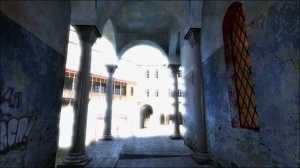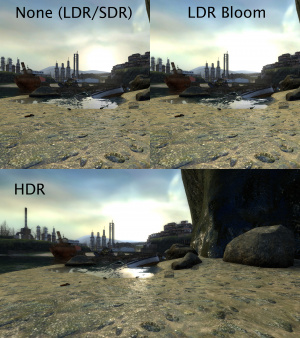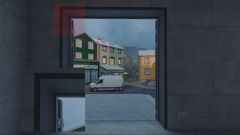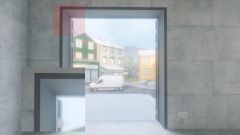HDR

High Dynamic Range (HDR) in ![]() Source and
Source and ![]() Source 2 refers to High Dynamic Range rendering (HDR Rendering for short, or HDR lighting), is the process of generating computer graphics scenes using lighting calculations done in high dynamic range (HDR). It simulates and automatically adjust brightness & exposure into neighboring areas, mimicking the way cameras and even eyes handle light exposure, then collapsing the image to
Source 2 refers to High Dynamic Range rendering (HDR Rendering for short, or HDR lighting), is the process of generating computer graphics scenes using lighting calculations done in high dynamic range (HDR). It simulates and automatically adjust brightness & exposure into neighboring areas, mimicking the way cameras and even eyes handle light exposure, then collapsing the image to ![]() Standard Dynamic Range (SDR, internally referred to in Source and Source 2 as LDR, for Low Dynamic Range) color range. This mainly involves "blooming" colors above 100% brightness into neighboring areas and adjusting a virtual camera aperture to compensate for any over-exposure that results.
Standard Dynamic Range (SDR, internally referred to in Source and Source 2 as LDR, for Low Dynamic Range) color range. This mainly involves "blooming" colors above 100% brightness into neighboring areas and adjusting a virtual camera aperture to compensate for any over-exposure that results.
Besides the obvious effects of this (see right), HDR gives richer colors, better contrast and finer gradients: since bright and dark areas are pushed into white and black, correctly exposed areas are drawn with a far wider range of values.
Predecessor to HDR
The GoldSrc game ![]() Counter-Strike (Xbox) has a feature called "Dynamic iris simulation". This adjusts the screen brightness depending on where you look.
Counter-Strike (Xbox) has a feature called "Dynamic iris simulation". This adjusts the screen brightness depending on where you look.
HDR in Source
HDR rendering was first demonstrated in ![]() Half-Life 2 during it's development (2003), but it was later eventually cut before Half-Life 2 was released. This is because the first few implementation of HDR at the time have limitations, preventing MSAA anti-aliasing, alpha mapping and fog effects from working, and back when Half-Life 2 was released, some users at the time did not have DirectX 9 capable GPU.
Half-Life 2 during it's development (2003), but it was later eventually cut before Half-Life 2 was released. This is because the first few implementation of HDR at the time have limitations, preventing MSAA anti-aliasing, alpha mapping and fog effects from working, and back when Half-Life 2 was released, some users at the time did not have DirectX 9 capable GPU.
Later, HDR rendering was reintroduced with ![]() Day of Defeat: Source, released in Sep 2005, and later demonstrated with Half-Life 2: Lost Coast, a tech demo (both of them runs on updated version of
Day of Defeat: Source, released in Sep 2005, and later demonstrated with Half-Life 2: Lost Coast, a tech demo (both of them runs on updated version of ![]() Source 2004). The implementation of HDR with the release of Day of Defeat: Source and Half-Life 2: Lost Coast allows the use of MSAA anti-aliasing, several effects are working as intended, and are compatible with any DX9+ GPU from NVIDIA and ATI (now AMD).
Source 2004). The implementation of HDR with the release of Day of Defeat: Source and Half-Life 2: Lost Coast allows the use of MSAA anti-aliasing, several effects are working as intended, and are compatible with any DX9+ GPU from NVIDIA and ATI (now AMD).
All subsequent Source branches starting with ![]() Source 2004 (since DOD:S) and
Source 2004 (since DOD:S) and ![]() Source 2006 later ships with HDR support out of the box. HDR requires DirectX 9 (
Source 2006 later ships with HDR support out of the box. HDR requires DirectX 9 (dxlevel 90 or higher) level GPU for Windows (or OpenGL 1.4 and later for macOS/Linux), and maps must be compiled with HDR lighting data. It is optional but recommended that the map's skybox textures are HDR-capable.
Additionally, ![]() Source 2007 improves HDR rendering by remade HDR tonemapping in order to better fits outdoor scenes. Eventually, HDR rendering became a requirement since Left 4 Dead engine branch.
Source 2007 improves HDR rendering by remade HDR tonemapping in order to better fits outdoor scenes. Eventually, HDR rendering became a requirement since Left 4 Dead engine branch.
Specific games
While HDR was introduced in both Source 2004 (since Lost Coast engine update) and Source 2006, initially in certain games such as ![]() Counter-Strike: Source and Half-Life 2 (both at the time having been upgraded to Lost Coast engine and Counter-Strike: Source was later Source 2006, Counter-Strike: Source only had some maps were compiled with HDR rendering, while Half-Life 2 had none until the engine (and Mac) update in 2010, upgrading it from Source 2004 to
Counter-Strike: Source and Half-Life 2 (both at the time having been upgraded to Lost Coast engine and Counter-Strike: Source was later Source 2006, Counter-Strike: Source only had some maps were compiled with HDR rendering, while Half-Life 2 had none until the engine (and Mac) update in 2010, upgrading it from Source 2004 to ![]() Source 2009 along with changes to the maps and skybox textures to support HDR. Half-Life 2 on console (The Orange Box for Xbox 360 and PlayStation 3, runs on Source 2007), did have HDR rendering in all maps, however.
Source 2009 along with changes to the maps and skybox textures to support HDR. Half-Life 2 on console (The Orange Box for Xbox 360 and PlayStation 3, runs on Source 2007), did have HDR rendering in all maps, however.
After May 2010 (when Half-Life 2 was ported to Mac, along with June 2010 update for Windows), up until November 2024 with Half-Life 2's 20th Anniversary Update, Valve did eventually add HDR to some maps, but forgot to compile all the maps with both LDR and HDR support in Half-Life 2, leaving some of the maps LDR only, and others HDR only, requiring users to enable HDR, otherwise the HDR-only map will be rendered in fullbright. This also increase map loading times due to the engine having to switch between LDR and HDR rendering. Other games such as Counter-Strike: Source (even when it's currently now running on Team Fortress 2 branch) still have some maps compiled with LDR lighting only, and have no effect when HDR is enabled.
Limitations
Source does not have a physically accurate HDR simulation. Its camera has a far wider range than the human eye (let alone real cameras), and it also adjusts to changes in brightness far faster (this can be adjusted through env_tonemap_controller's SetTonemapRate keyvalue however). Both of these are expedient to gameplay of course, especially in multiplayer.
Source does not create "proper" HDR images, and does not officially support native HDR output for HDR-capable TV/monitors, due to the engine being built for hardware & software at the time (including DirectX 9 API and lack of HDR-compatible monitors & HDR display support on older graphics card). Instead, it collapses the image down to SDR color range early. The average user would be hard-pressed to tell the difference, however, and the benefits include support for all DX9+ GPUs, MSAA compatibility, and excellent performance.
On systems with Windows 11, you can use Auto HDR, RTX HDR Nvidia GPUs only) or other methods here as a workaround. Note that Auto HDR only works with Source games running on Direct3D 11. Most Source games (which usually run on Direct3D 9) requires ![]() dgVoodoo2 to translate D3D9 to D3D11/D3D12, allowing the use of Auto HDR. Keep in mind that using dgVoodoo2 is not recommended on Source 2006 games or earlier, as it will break the gray fog/dense fog bug fix on NVidia GPUs. Alternatively, you can use RTX HDR, which works with Direct3D 9, 11 and 12.
dgVoodoo2 to translate D3D9 to D3D11/D3D12, allowing the use of Auto HDR. Keep in mind that using dgVoodoo2 is not recommended on Source 2006 games or earlier, as it will break the gray fog/dense fog bug fix on NVidia GPUs. Alternatively, you can use RTX HDR, which works with Direct3D 9, 11 and 12.
LDR deprecation in newer games
Since the Left 4 Dead engine branch and later games (with some exceptions), HDR rendering is now required and LDR/SDR rendering has been deprecated, with the option to disable HDR removed.
Despite LDR being deprecated since ![]() Left 4 Dead, some games like
Left 4 Dead, some games like ![]() Portal 2 as well as the original release of
Portal 2 as well as the original release of ![]() Dota 2 allow users to disable HDR through console commands, however:
Dota 2 allow users to disable HDR through console commands, however:
- In Portal 2, while you can disable HDR using console commands (
mat_hdr_level 0), no Portal 2 maps have LDR lighting compiled by default, which will cause "mat_fullbright" ('full bright' lighting) to be enabled. - In the original release of Dota 2, the game only uses LDR lighting, and none of the maps appear to have HDR lighting data. Additionally the game does not have an option to enable HDR aside from using console commands.
- In Left 4 Dead and
 Left 4 Dead 2, HDR can be only disabled via the launch command (
Left 4 Dead 2, HDR can be only disabled via the launch command (mat_hdr_level 0) as the command is hidden ingame, but you can use SourceMod (for L4D) or VScript (for L4D2) to disable it while the game is already running.
HDR in Source 2

Source 2 continue to use HDR rendering like Source, however it has been improved.
![]() Counter-Strike 2 adds a option for switching between Performance and Quality HDR. In most cases both HDR settings looks nearly identical, except the former was less demanding, and will produce noisy film grain effect (which are largely unnoticeable at native resolution).
Counter-Strike 2 adds a option for switching between Performance and Quality HDR. In most cases both HDR settings looks nearly identical, except the former was less demanding, and will produce noisy film grain effect (which are largely unnoticeable at native resolution).
However, if you enable FSR upscaling, Performance HDR will make film grain effect more noticeable (especially when the exposure & brightness is low), while Quality HDR doesn't.
Top - Low exposure & brightness, Bottom - High exposure & brightness
Like Source, Source 2 does not officially support displaying HDR rendered images on HDR-compatible displays.
See also
External links





